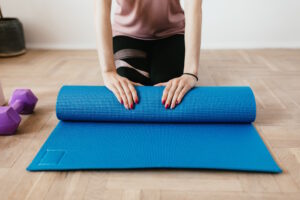
Starting a new fitness routine, such as Pilates, can be an exciting and transformative journey. If you’re a beginner looking to delve into the world of Pilates, you may be wondering what equipment is necessary to get started. Fortunately, Pilates can be practiced with minimal equipment, making it accessible for beginners. In this comprehensive guide, we will explore the essential equipment needed for Pilates beginners and provide insights on how to prepare for your first Pilates session, whether it’s at a studio or in the comfort of your own home.
What equipment do I need to start Pilates?
One of the appealing aspects of Pilates is that it can be practiced with minimal equipment, making it accessible for beginners.
1. Pilates Mat: A Pilates mat is the most fundamental piece of equipment you’ll need. It provides a cushioned surface for exercises, supports your body, and helps maintain proper alignment. Look for a mat that offers adequate thickness, grip, and durability.
2. Comfortable Clothing: Opt for comfortable, breathable clothing that allows for a full range of movement. Choose form-fitting attire that doesn’t restrict your movements, ensuring that you can perform exercises comfortably.
3. Towel and Water Bottle: Pilates can be a challenging workout that engages your muscles and raises your heart rate. Keeping a towel and water bottle nearby will help you stay hydrated and wipe off any perspiration during your practice.
4. Optional Props: While not essential, some props can enhance your Pilates practice. These may include resistance bands, small Pilates balls, foam rollers, or Pilates rings. These props can add variety and challenge to your workouts, targeting specific muscle groups or providing additional support when needed.
How do I prepare for Pilates for the first time?
Preparing for your first Pilates session is key to ensuring a smooth and enjoyable experience. Consider the following tips:
1. Research Pilates Studios or Online Platforms: If you plan to attend Pilates classes at a studio, take the time to research reputable studios in your area. Look for qualified instructors who have experience working with beginners. Alternatively, if you prefer practicing at home, explore online platforms or instructional videos that cater specifically to Pilates beginners.
2. Wear Appropriate Clothing: Choose comfortable, form-fitting clothing that allows for a full range of movement. Avoid clothing with zippers, buttons, or anything that may cause discomfort while lying or stretching on the mat.
3. Arrive Early: If you’re attending a studio class, aim to arrive a few minutes early to familiarize yourself with the environment, meet the instructor, and set up your mat and any required props. This will help you feel more at ease before the class begins.
4. Communicate with Your Instructor: Whether it’s your first Pilates class or you have specific concerns or limitations, don’t hesitate to communicate with your instructor. Inform them about any injuries, physical limitations, or if you’re unsure about certain exercises. They can provide modifications or alternative exercises to ensure your safety and comfort.
How to do Pilates for beginners at home?
Pilates can be conveniently practiced at home, allowing you to incorporate it into your daily routine. Follow these guidelines for a successful Pilates session at home:
1. Designate a Space: Set aside a dedicated space in your home for your Pilates practice. Clear the area of any potential hazards and ensure you have enough room to stretch and move freely.
2. Create a Comfortable Atmosphere: Make your practice area inviting by using natural light, playing soothing music, or using scented candles or essential oils to create a calm ambiance.
3. Follow Online Videos or Programs: Explore online platforms or instructional videos specifically designed for Pilates beginners. These resources provide structured workouts, guided instructions, and demonstrations to ensure you’re performing the exercises correctly.
4. Focus on Proper Form and Alignment: Pay attention to your form and alignment throughout the exercises. Start with the basic movements, gradually progressing as you gain strength and confidence. Remember to engage your core, maintain proper posture, and listen to your body’s limitations.
What is beginner-level Pilates?
Beginner-level Pilates refers to the initial phase of your Pilates journey. It introduces you to the fundamental principles and basic exercises, focusing on building core strength, flexibility, and body awareness. Beginner-level Pilates classes or workouts typically involve a slower pace, allowing beginners to become familiar with the movements, alignment, and proper breathing techniques.
During beginner-level Pilates, emphasis is placed on mastering the foundational exercises and developing a strong mind-body connection. As beginners progress, they can gradually incorporate more challenging movements and increase the intensity of their workouts.
In this comprehensive guide to essential equipment for Pilates beginners, we explored the minimal equipment required to get started, including a Pilates mat, comfortable clothing, and optional props. We also discussed tips on preparing for your first Pilates session, whether at a studio or at home, highlighting the importance of researching studios, wearing appropriate clothing, arriving early, and communicating with your instructor. Additionally, we provided guidelines for practicing Pilates at home, such as designating a space, creating a comfortable atmosphere, and following online videos or programs. Lastly, we explained that beginner-level Pilates focuses on introducing fundamental principles and basic exercises, allowing beginners to develop core strength, flexibility, and body awareness. By following these guidelines and incorporating Pilates into your routine, you can embark on a fulfilling Pilates journey and experience its transformative benefits for your mind and body.